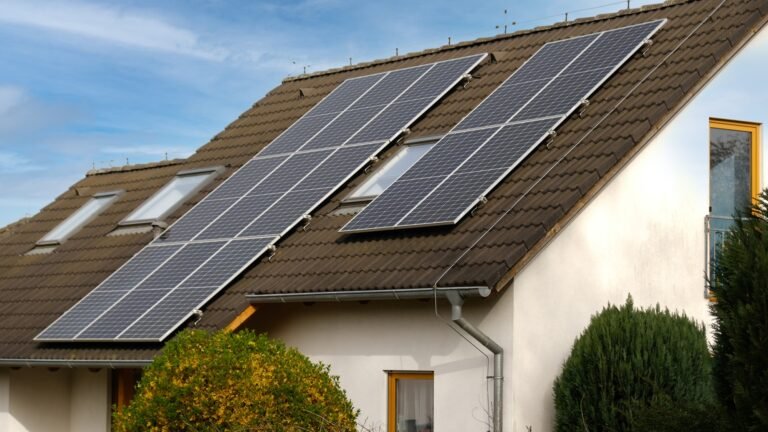Amid rising electricity prices and growing concerns about the environment, more and more homeowners are looking for ways to go green. Power up your home, and help protect the planet: Using that vault of clean energy to power our homes is one of the most revolutionary things we can do. Whether you are concerned about high utility bills, a lack of power backup during frequent outages, or your carbon footprint, before you make the switch to solar energy for home there are some things to consider and plan for. This guide will help you understand how much sunlight your house gets, installation considerations, battery storage options, and what federal, state, and local incentives are in your area. By evaluating these key factors before laying down battery, so to speak, you can take control of your home’s energy destiny and help make the world a more sustainable place.
Assessing Your Home’s Solar Readiness
Before you purchase a solar energy system, take the time to perform a budget analysis including your potential energy savings. Begin by looking at the structural integrity, age and materials that make up your roof. What type of roof?: Your best candidates are roofs that have at least another 10-15 years of life left and were built using quality materials like asphalt shingles, metal, or tile. The orientation and slope of the roof are also important – a 30-45 degree angle facing south will yield the most sunshine in North America.
When evaluating sun exposure, you may want to use solar pathfinder tools or smartphone apps that record daily sunlight patterns. These tools assist in identifying the potential for shading by trees, nearby structures, or other obstructions. Your system’s potential efficiency is also affected by weather and local climate such as the number of average sunny days, seasonal weather patterns, and typical cloud cover. 4-5 hours of sunlit exposure per day is ideal for solar energy production in most regions.
In addition, your current home electrical system should be conditioned for solar. Check the capacity in your electrical panel- most solar installations in the modern era typically need 200 amp service. By performing an in-depth examination of your current wiring and grounding system, as well as your circuit breakers, we are able to determine any upgrades needed to meet the needs of your home. While DIY calculators give you a rough idea, a professional solar audit lets you know everything there is to know about how your home’s structure, electrical and surrounding environment is going to affect your shipped solar and ultimately, if your home is a good fit to go solar.
Safe Solar Installation: Your Step-by-Step Guide
Professional Installation Required
DIY installation is not supported. All systems must be installed by an EcoFlow certified professional to ensure safety, performance, and compliance with warranty terms.
Equipment Selection and Site Preparation
Match solar panels to your roof and the local climate. Monocrystalline panels usually provide the best efficiency for your home’s limited surface area, while polycrystalline ensure a budget-friendly solution for a bigger real estate. For partly shaded roofs, microinverters may be a better fit, while for unshaded installations, string inverters could be better. Prior to beginning work, provide and install safety barricades, roof access and equipment staging areas. Check your install crew’s knowledge of electric shutoffs and emergency procedures.
Post-Installation Inspection and Activation
Once installed, arrange full inspections with your community’s building department and the utility company. Your installer should run a full system test, measuring voltage, checking the grounding and configuring performance monitoring. Record all safety components, isolation devices and correctly labelled solar equipment. Fill out this interconnection agreement, and get an authorization to operate before you begin generating! Keep a log of all service and/or installation documents or store the entire warranty package.
Battery Storage Integration Essentials
With today’s battery storage systems, solar systems become more than just daytime-only producers of energy. While you are thinking about your battery system’s capacity, it’s important to consider your home and what appliances will be on during the peak and what it will supply in backup. Typically a home needs between 20-40kWh of storage to keep essential loads running during an outage, and whole home backup as much as 60-80kWh or more may be called for. EcoFlow and other leading manufacturers are delivering modular solutions that can be tailored to fit your energy needs. When analyzing optimal size, consider seasonal differences in energy demand and future use, such as for electric vehicle charging.
Flexible battery systems include several backup power options that allow you to prioritize what’s most important. Provides whole house power backup—circuits can be cycled on and off so there’s no attempt to power everything at once — and critical load backup— turning on only essential systems such as refrigeration, heating/cooling system and medical equipment. Intelligent energy management capabilities help to maximize power flow by coupling excess solar generation during peak production times and by discharging stored energy during periods of high demand or when the grid is offline. Some even anticipate the weather and their charging decisions follow suit.
Combine for hassle-free maintenance service by adding quarterly system checks and yearly professional service to your new equipment investment. Track battery temperature, charging cycles, and system status via management software. Maintain clean, properly-ventilated, and temperature-controlled battery enclosures. There’s even remote monitoring options built into most systems, meaning homeowners and snow removal professionals are able to monitor performance and respond to potential problems as they arise. At that time, with good service and operation, the systems can still support solid resiliency and energy optimization for 15 or more years.
Maximizing Financial and Environmental Benefits
Knowing what incentives are available will help you net the most money back from your solar investment. The federal solar tax credit, which you can use to claim 30% of the cost of your new solar system including battery storage, is still in place. Most states have their own tax credits, too, some between 10-25% of system price. Many areas have property tax exceptions that keep home-valuation increases from jacking up property taxes on your home, and some regions have sales tax exceptions for the purchase of solar equipment.
You can earn credits for extra power your system delivers to the grid by taking advantage of net metering programs. These credits go against the electricity you consume when your array isn’t producing power — usually at night or when it’s cloudy. Some utilities have time-of-use rates, with which you can save the most by consuming stored power during peak rate times. You can make more money from your solar by joining a Virtual Power Plant, which allows you to earn extra revenue by providing support to the electricity grid and earn from $100 to $1,000 per year depending on your state and size of system.
It is all part of the green effort and why you should go solar, a consideration of the environment beyond your immediate and direct one. An average household solar system can remove 4-5 metric tons of carbon emissions per year – the same as planting 100 trees. With the addition of battery storage, your system can even ease grid tension during peak times of use, leading to city-wide energy resiliency and decreased dependence on fossil fuel power plants. This environmental benefit lens expands over the life of your system, so both short and long-term savings are in play.
Taking Control of Your Energy Future
Switch to solar with battery storage and take charge of your energy freedom and the environment. Before you start the installation process, be sure your house is structurally sound, from a roof that’s in good condition to a compatible electrical system. Just remember not to sacrifice safety while installing it, we all know safety comes first – and going through the right process of installation and hiring a professional to do the work will not only secure your investment but also ensure to safeguard every member of the family. Advanced battery storage solutions have converted solar from a daylight-only power resource to a full-time distributed energy solution that’s always on, providing backup power and enabling intelligent energy management. Not only are you investing in the future of your home, but you are also committing to a greener world by leveraging existing financial incentives, and having a clearer picture of how your system impacts the environment. Act now and set up a free solar consultation to see if all this solar energy can benefit you and your family for generations to come!


































